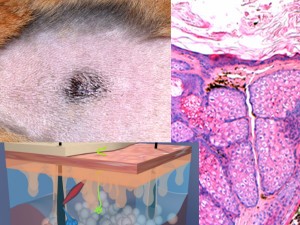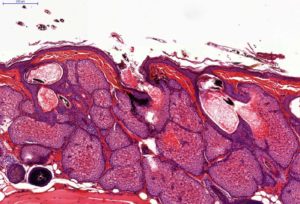Hamster Flank Organ Acne Model / Overview
Introduction
Hamster flank organ acne model is an animal model which has been extensively used for the study of compounds inhibiting the response of sebaceous glands to hormones, anti-androgens, and retinoids.
The hamster flank organ is composed of clusters of large sebaceous glands.
This organ has a bilateral localization on animals abdomen and is used to produce pheromones and marking molecules of mature males.
Protocol summary
Typical Results
| Evaluation | Parameter | Group control (excipient / topical) | Test group (retinoid / topical) |
|---|---|---|---|
| In vivo | Bodyweight | NE (No Effect) | NE or decrease |
| Flank organ size | NE | Slight decrease | |
| Back skin scaling (visual scoring) | NE | Slight increase (dry skin appearance) | |
| Back skin erythema (visual scoring) | NE | Increase (irritation) | |
| Back skin thickness (calipering) | NE | NE or increase | |
| Epidermis thickness (OCT / Optical Coherence Tomography) | NE | Increase | |
| Ex vivo (histology) | Sebaceous glands | NE | Decrease |
| Sebum surface | NE | Decrease | |
| Sebaceous glands inter-lobular spaces | NE | Increase | |
| Epidermis thickness | NE | Increase (epidermal hyperplasia) |
|
| Dermis inflammation | NE | Increase (local inflammation slight to moderate) |
Hamster Flank Organ Acne Model / Detailed protocol
Application of dermatological pharmaceutical products:
– Ready to use formulations / Formulation screening on request
– Topical & Oral routes / Reference drugs: Isotretinoin or Adapalene or Bexarotene
– Intra-dermal route (i.e. Medical Devices or injectable drugs)
– Treatment duration: >3 weeks
Evaluation of clinical macroscopic signs:
– Body weight / General behavior
– Flank organ size and length / Caliper
– Back skin thickness / Caliper
– Flank organ and surrounding skin macroscopic description:
Scaling (skin dryness)
Erythema (skin redness)
Other macroscopic skin observations

In vivo imaging:
– Macroscopical observation: Digital pictures of flank organs
– Sub-macroscopical exploration: Optical Coherence Tomography (OCT) for epidermis thickness measurement and superior sebaceous gland structure (on development)
– Ultrasonography for flank organ size evaluation
Other ex vivo imaging techniques of interest:
– 3D reconstruction of sebaceous glands for volume evaluation
– Light Sheet microscopy (in collaboration)
– MALDI tissue imaging (in collaboration)
Hamster Flank Organ Acne model / Conclusion
Hamster flank organ model is a first intention model validated anti-androgens family of compounds.
6 to 8 animals per group are generally sufficient to underline anti-acne effect of new therapeutics (based on difference of at least 20% / sebaceous glands surface or sebum surface).
Do not hesitate to contact us if you need more information or a quotation on this model.
Bibliography of interest
- Franz, T. J., et al. The hamster flank organ model: is it relevant to man? J. Invest. Dermatol. 93, 475–9 (1989).
- Weissmann, A., et al. Morphometric Studies of the Hamster Flank Organ: An Improved Model to Evaluate Pharmacologic Effects on Sebaceous Glands. J. Invest. Dermatol. 82, 522–525 (1984).
- Gomez, E. C. & Moskowitz, R. J. Effect of 13-cis-retinoic acid on the hamster flank organ. J. Invest. Dermatol. 74, 392–397 (1980).
- Orentreich, N. et al. The local antiandrogenic effect of the intracutaneous injection of progesterone in the flank organ of sexually mature male Syrian golden hamster. Arch. Dermatol. Res. 276, 401–405 (1984).
- Piskin, S. & Uzunali, E. A review of the use of adapalene for the treatment of acne vulgaris. Ther. Clin. Risk Manag. 3, 621–624 (2007).



